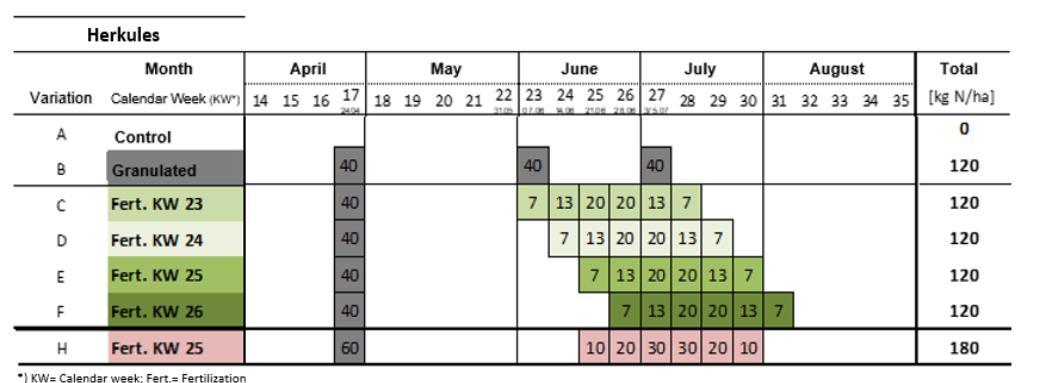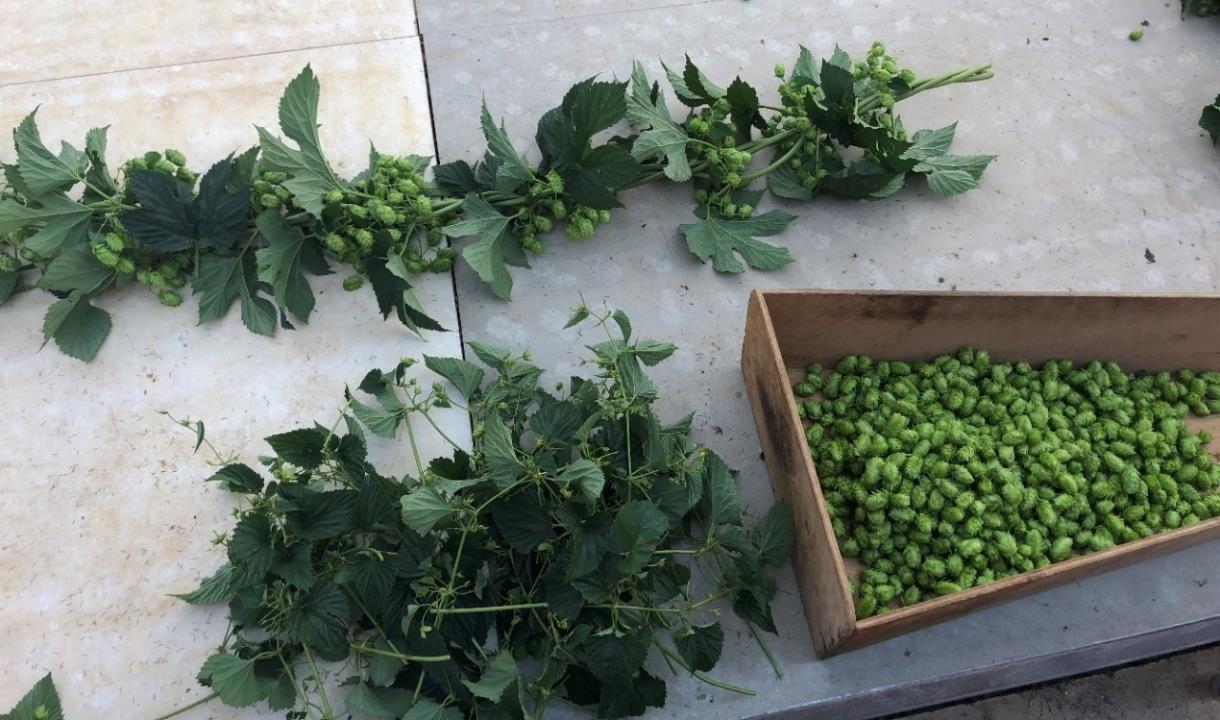
6 minute read
nitrogen fertilization
Analyses of the densities below the two drip hose positions showed that the soil underneath the surface irrigation had an average density of 1.3 g/cm³ compared to 1.7 g/cm³ underneath the underground irrigation. This difference is significant. The density differences can also explain why, for underground irrigation methods, the root density below the soil surface was not significantly higher than with above-ground irrigation methods or without any irrigation at all. In the loose top soil layer, however, surface irrigation had a positive influence on the number of fine roots there.
Outlook
The method of analyzing the side wall of a sample soil block provided interesting findings that help explain the influence of the drip hose position and the type of fertilizer application on yield and quality. However, any analysis must also take into account the huge variability of individual hop plants. This is necessary because it has not yet been possible to repeat the tests described above for 20 samples which would allow for the averaging-out of such individual plant variations.
4.6 Investigation of the hop yields a function of the amount and timing of nitrogen fertilization
Team: A. Baum (Bachelor Thesis) S. Arnold (Bachelor Thesis) J. Stampfl Collaboration: Prof. Dr. T. Ebertseder, Fakultät Nachhaltige Agrar- und Energiesysteme, (Faculty of Sustainable Agriculture and Energy Systems) Hochschule Weihenstephan-Triesdorf Duration: July 2019 to November 2019
Background and objectives of the project
Between 2017 and 2019, the Bavarian State Research Center for Agriculture conducted extensive N-fertilization tests as part of the project, "Improving nutrient efficiency in hops through fertilization systems with fertigation." In these experiments, different amounts and variations of the timing of nitrogen fertilization resulted in yield variations. To better understand these differences from a plant physiology perspective, in 2019, two bachelor theses examined the differences in yield and the differences in the seasonal plant evolution as a function of the type and timing of fertilization for Perle and Herkules.
Methods
The investigations were carried out at two locations in 2019. One was planted with Perle, the other with Herkules. Figure 4.14 shows the fertilization regimen for the Perle site, and Figure 4.15, the one for the Herkules site.
At both locations, controls without N-fertilization (A) served as references, as did a plot fertilized with three equal rounds of granulated fertilizer (B). For the fertigated plants (C to F), one-third of the fertilizer requirement was administered in the form of granulated fertilizer and two-thirds via irrigation. The fertigated plants had different start dates for their 6-week fertigation period.
Figure 4.14: Perle fertilization schedule, favorable growing location, 2019, granulated additions are colored in gray; fertigated additions, in green In addition, for the Herkules study, there was a separate test H (next to tests A to F), in which the total amount of applied N was 50% higher.

Figure 4.15: Herkules fertilization schedule, medium location, 2019, granulated additions are colored in gray; fertigated additions, in green The development of all plants except the controls was tracked over time. For this purpose, bines were culled from each of the plants under investigation and analyzed in terms of their yield development. Timing for the sampling was determined by the variety-specific optimal harvest date; and the bine selection was guided by the similarity of the bines compared to the average appearance of the plants in the neighboring “normal”production plots. This scheme is represented in Figure 4.16.

Figure 4.16: Division of bine into segments and areas
1. Division of the bine into sections: crown, top, middle, bottom, base (the crown section was the part of the bine that grew above the height of the poles) 2. Separation of sections into the areas: central bine and lateral shoots (this separation was only possible and useful in the top, middle and bottom sections; shoots were considered lateral if they arise from the leaf axils and were at least 10 cm long) 3. The cones of the 8 bine fractions were plucked by hand and placed in separate containers 4. To determine the cone size and number per fraction, a sub-sample of around 150 to 250 cones was spread out on white trays and recorded. An image processing program then counted the number of cones and determined the mean cone size. Using the weight of the partial sample and the weight of the entire fraction, the number of cones for each fraction could be extrapolated. At the same time, the mean cones weight could be determined 5. Finally, the length and number of the culled lateral shoots were determined

Figure 4.17: Culled lateral shoots next to the central bine with the so-called (Hallertauer vernacular) "axil hops" of a section
Results
Representative bines of the test group (B) served as a reference for the subsequent assessment of yield developments as a function of different types of nitrogen fertilization. In both varieties, the crown, top and middle sections held most of the cones: some 80% in Herkules and 82% in Perle. The differences between the central bine (the so-called "axil hops") and the lateral shoots showed that only a very small part of the cone yield resided on the central bine (13% in Herkules and 10% in Perle) and that a much larger portion forms on the lateral shoots (Table 4.5).
Table 4.5: Distribution of cone yields in Herkules and Perle, divided into different bine sections and areas (in % of cone yield/bine in g)
Segment Herkules (in % of 928 g) Perle (in % of 782 g) Total Plant Central Bine Lateral Shoots Crown Total Plant Central Bine Lateral Shoots Crown
Crown 11 11 8 8
Top 36 9 27 37 7 30 Middle 34 4 30 37 3 35 Bottom 18 1 17 17 1 16 Base 2 0 2 1 0 1
Sum 100 13 76 11 100 10 82 8
Because of the importance of the lateral shoots for yield formation, they were examined more closely. From the length and number of side shoots per section, the total side shoot length per section could be calculated. Table 4.6: Lengths of lateral shoots by bine sections and percentage changes per section depending on N-fertilization methods, Herkules, 2019
Section
Lateral shoot length in m
Granulated Fertigation starting at calendar week 25
Fertigation starting at calendar week 26 Top 12.0 15.9 +32 % 13.7 +14 % Middle 16.9 17.9 +6 % 14.8 -12 % Bottom 24.4 22.0 -10 % 14.2 -42 % Base 22.9 16.0 -30 % 11.4 -50 %
Sum 76.2 71.8 -6 % 54.1 -29 %
Table 4.6 shows changes in the length of the lateral shoots in the individual sections depending on the fertilization method, using Herkules as an example. It turns out that later fertilization dates (starting in calendar week 25) shifted the formation of lateral shoots into the upper bine sections without a significant decrease in the total length of the lateral shoots. At an even later start of fertigation (starting at calendar week 26), 14% more or longer lateral shoots were formed in the upper section, but the lateral shoot length was reduced in all other sections. As a result, the sum of the lateral shoot lengths as measured in the reference plants could no longer be achieved (- 29%). Next was the calculation of the amount of cones (in grams) formed per meter of lateral shoots, in the respective sections. This is a key figure that can be used to define the yield relevance of the length of the lateral shoots for the respective sections. The values are as follows:

Figure 4.18: Aggregate cone weight per meter of side shoots in g/m relative to the reference, divided by bine sections









